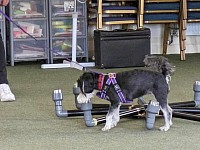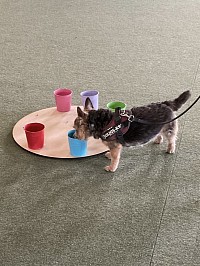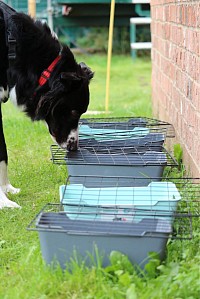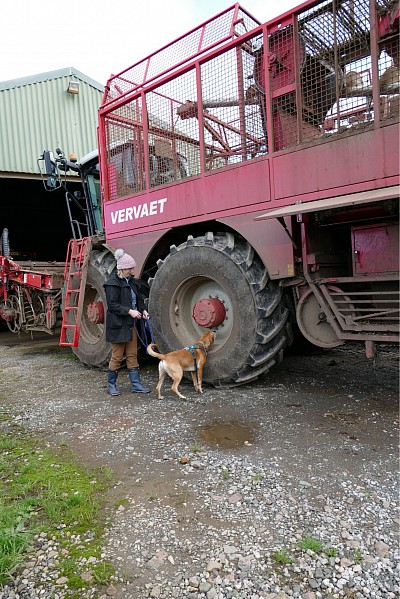International Animal Behaviour and Training Centre. Scentdog Trials
The IABTC Scentdog Trials are aimed at hobby handlers, it has five levels.
Foundation
A key point is that the source of odor is accessible to the dog at this level. We take into consideration that there will be small dogs, large dogs, and disabled dogs. It is always our goal that the hides be achievable for the title level; but remember, there will be unpredictable elements in searches, so create the unpredictable in your training and let your dog learn to solve the problems.
The dog will seek out the exact source of the odor.
The handler can identify the dog’s communication of the exact source.
The dog wants to find odour regardless of the environment around him.
Apprentice
Since the team has proven the ability and understanding of going to source, new challenges are introduced. These include things such as thresholds, hides at different heights, mixed environments (say a kitchen and an office, or exteriors with a hide in the concrete and a hide in tree), new vehicle configurations, new types of vehicles and containers, and, of course, distractions (generally in the container search). Teamwork between handler and dog becomes more important as the handler may need to recognise odour obedience over object focus or decide when to put the dog on and off the leash.
The dog can find multiple hides in one environment.
The dog and handler team can work through more challenging, less accessible hides.
The dog can overcome food and toy distractions and alert only to odor.
The dog can manage larger search area
Journeyman
Proficient in two of the odours
The dog can find an unknown number of hides in a search environment.
The handler will recognise the search behavior in a dog when no odor is present (if there is a blank area).
The dog and handler team can work through even more challenging, less accessible hides with varying heights and containment.
The dog can overcome food and toy distractions in any environment and alert only to odor.
· The dog can manage longer, larger searches.
Skilled Search Team
Proficient in three of the odours
The dog can find an unknown number of hides in a search environment.
The handler will recognize the search behavior in a dog when no odor is present (if there is a blank area).
The dog and handler team can work through even more challenging, less accessible hides with varying heights and containment.
The dog can overcome food and toy distractions in any environment and alert only to odor.
· The dog can manage much longer, larger searches.
Master Search Team
Proficient in three of the odours
Number of hides will not be stated on any of the search areas or elements. There may be zero, one, two or three hides in any of the search areas. However, there will be no more than one Blank Area (search area with zero hides) per trial and it is possible a trial may not have a Blank Area. In the event of a Blank Area, the ‘Finish’ call will be worth one hide.
• In each search the handler must locate all hides and call ‘Finish’ before the time runs out to achieve full points for that search.
Which may comprise:-
- Interior Searches placed inside any structure with a roof and minimum of 3 walls.
May be on or off leash as designated by the Certifying Official.
- Container Searches
On leash or off leash as specified by the Certifying Official for each search
No intentional distractors.
Container searches will be boxes in any arrangement with no distance set
- Exterior Searches placed anywhere outdoors, preferably in an area without a roof. Covered areas must have a maximum of 2 walls.
On leash; may be off leash option if specified by the Certifying Official, but only if area is secure.
- Vehicles Search placed on any vehicle used for transportation. Odour will not be placed inside or on the undercarriage of any vehicle
On leash or Off Leash as specified by the Certifying Official.
May include single vehicles or multiple vehicles.
Odours
Odours that may be requested to be used in these trials are:-
Birch
Clove
Gun oil
Truffle oil
Catnip
Foundation Search Team
Open to dogs who have not gained a comparable title with another organisation, and whose handlers are neither, Scent work Judges or have worked as professional detection dog handlers.
This level is comprised of two parts.
both interior hides
The first being an odour recognition test, this may take the form of a row or trail of bricks, or a row or trail of identical containers. This tests the dogs understanding of their scent role and the handlers ability to work their dog on lead to clear the test pattern. The dogs will have three runs (not consecutive). Time 3min. Gaining 2 or more finds they can then enter the second part which is a:-
- Single hide place no higher than 24 inches from the ground.
- The dog will be able to reach the source.
- There will be no buried hides.
- Time allowed 5 mins (a time check will be given on request).
- The qualifying score is 75% if you score this on two occasions you will move up to Apprentice. You can continue to take part in Foundation but only as not for competition
- Rosettes will be awarded 1st to 5th Placings
Apprentice Search Team
Open to dogs who have not gained a comparable title with another organisation, and whose handlers are neither, Scent work Judges or have worked as professional detection dog handlers.
A scent run will be set up away from the Trial site where competitors may ask to have a test scent placed and run the pattern. This is not part of the trial and is at the competitors discretion.
No Blank Areas. (Search areas without odor that must be searched and indicated to be clear of odour).
No Buried Hides
• Height and accessibility of hides – Should be no more than approximately four (4) feet high. The location of source will be identifiable by the dog.
A note about height: The height parameter is a general guideline provided for training purposes. No trial location will ever be the same. If a kitchen counter were 3 inches taller than the specified guideline, it could still be used for a hide location as long as the dog would be able to gain access to it with the handler’s help.
The Trial is built on the Foundation level. It comprises two hides
Two hides one an exterior search and interior
- First hide placed no higher than 2feet from the ground. The dog will be able to reach the source.
- Second hide will be no higher than 4 feet and will be positioned where the dog has to work to get to source.
- There will be no buried hides.
- Time allowed 5 mins (a time check will be given on request).
- The qualifying score is 75+ 300 points you will move up to Journeyman
- You will no longer be able to enter Foundation after getting a qualifier in apprentice (you can enter Not for competition).
- Rosettes will be awarded 1st to 5th Placings
Journeyman Search Team
Open to dogs who have not gained a comparable title with another organisation, and whose handlers are neither, Scent work Judges or have worked as professional detection dog handlers.
This level Each will comprise 3 searches.Comprising any of the four Elements. If containers are use distractions may be included this may be food or toys. Distractors will be enclosed in one of the containers.
Each search will have an unknown number of hides, you will be given a range (for example: 1 to 5 hides, or 0 to 3 hides). Any one of the searches may be a Blank Area with no hides. In the event of a Blank Area, the ‘Finish’ call will be worth one hide.
In each search the handler must locate all hides and call ‘Finish’.
Containers may be a combination of containers (no fabric containers)
There may be buried hides, this may be in packaging, in the ground (no more than 2in deep) or in water.
Height & Accessibility of hides – Should be no more than approximately six (6) feet high. And accessible with assistance for all dogs. The odour will be accessible to the dog, but the source may not be. For example, the hide may be located in a file cabinet drawer.
The qualifying score is 75+ if you score this on three occasions you will move up to Skilled SearchTeam Level
Skilled Search Team
Not open to those who have worked as professional detection dog handlers.
Skilled Search Team Trials will not be broken out by element.
Trials may contain any combination of interior, exterior, vehicle, and/or container searches. For example, a trial may have an exterior search area that also includes vehicles, or it might consist of all interior searches.
At an Skilled Search Team Trial, there will typically be 3-5 searches for each trial. This number may vary however to allow for more locations to be obtained for trials.
Difficulty will be adjusted by the Certifying Official through selection of areas, hide placement, etc. Search areas will tend to be varied in environment for each trial. At each trial, there will be a maximum time limit set for each search. The location of all hides will remain in the same spot for all competitors.
Skilled Search Team Requirements.
• Each search area may contain odor #1 (Birch) and/or odor #2 (Anise) and/or odor #3 (Clove) or a combination odor of any of the three odors or multiples of the same odor.
• Teams must have earned their NW3 Journeyman title to be eligible to compete in an Skilled Scent Team Trial.
• Each search area will be clearly defined, and a time limit will be given for the area. Timers will make their best effort to give a 30 second warning unless otherwise defined prior to the search.
• Searches may have an unknown or known number of hides for the area. This will be information given to the handler prior to starting the search. For an unknown number, you may be given a range – for example: 0 to 5 hides. If no range is given and it is an unknown number, then there may be any number of hides (or zero hides) in the area.
• The team will accrue points for each hide found (or call made in the case of an area with no hides). The total possible points will be 100. The points for each hide/call will be equal to 100 divided by the total number of hides/calls. For example, if there are 10 total hides/calls then each hide will be worth 10 points. If there are 14 total hides/calls, then each hide will be worth 7.14 points. In the case of a search with no hides, a correct ‘Finish’ call is worth 2 hides. Points will be deducted for each False Alert call and also for each timed out (failure to call ‘Finish’ prior to time elapsing). There will also be a 1-point deduction for each fault.
400 points required to move to Master Level
Master Search Team.
Not open to those who have worked as professional detection dog handlers
Since the team has proven the ability and understanding of going to source, new challenges are introduced. These include things such as threshold hides at different heights, mixed environments (say a kitchen and an office, or exteriors with a hide in the concrete and a hide in tree), new vehicle configurations, new types of vehicles and containers, and, of course, distractions (generally in the container search). Teamwork between handler and dog becomes more important as the handler may need to recognise odour obedience over object focus or decide when to put the dog on and off the leash.
The dog can find an unknown number of hides in a variety of search environments.
The handler will recognise the search behavior in a dog when no odour is present (if there is a blank area).
The dog and handler team can work through even more challenging, less accessible hides with varying heights and containment.
The dog can overcome food and toy distractions in any environment and alert only to odour.
The dog can manage much longer, larger searches and maintain concentration for longer periods.







